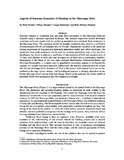Aspects of seasonal dynamics of flooding in the Okavango delta

View/
Date
2005Author
Wolski, P.
Masaka, T.
Raditsebe, L.
Murry-Hudson, M.
Publisher
Botswana SocietyType
Published ArticleMetadata
Show full item recordAbstract
Seasonal changes in inundation area and peak flood occurrence in the Okavango Delta are analysed using a multiple regression technique. The multiple regression models developed constitute useful and simple tools for predicting inundation area and peak flood occurrence in the Okavango Delta. The regression model for monthly inundation area achieves a coefficient of determination of 0.80 and standard error of 538 km². Explanatory variables in the model are various expressions of long-term and short-term antecedent rainfall and inflow conditions. The model for flood peak occurrence can be used for accurate predictions only in the Jao-Boro distributary, for which it achieves a coefficient of determination of 0.85 and standard error of 15 days, with distance to Delta inlet and an expression of flood size as explanatory variables. Propagation of the flood in the two other analysed distributaries, Maunachira-Khwai and Mboroga-Santantadibe, is complex and its quantitative description appears to be beyond the capacity of a simple regression approach. Additionally, the analyses presented provide insight into the role of storage in the dynamics of flood in the system: hydrological inputs are accommodated in the large system storage, and hydrological response is strongly dependent on the factors affecting (slow!) release from that storage. Based on the analyses, the classic model of kinematic flood wave propagation has been adapted accordingly.
Collections
- Research articles (ORI) [270]
